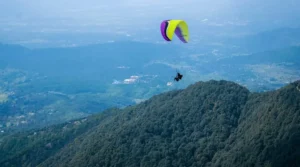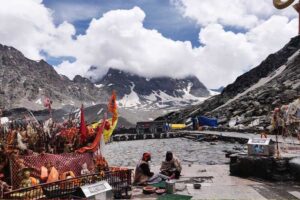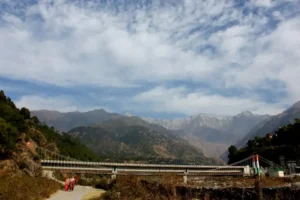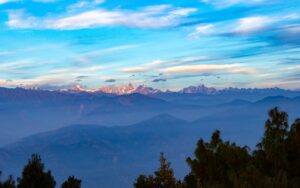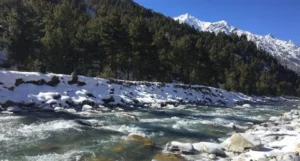Manimahesh Yatra 2024 Guide – Best Tips & Routes

Manimahesh Yatra, one of the toughest pilgrimages in India, is held in honour of Lord Shiva. It also makes a thrilling & adventurous trek which takes you amidst the lavish and beautiful setup of mighty Himalayas to the banks of Holy Dal Lake at a height of 13,390 feet above the sea level. This holy destination is situated in Bharmour Sub-Division of Chamba District of the state of Himachal Pradesh Tour package. The religious significance of this lake is next to that of the Lake Mansarovar in Tibet. The Manimahesh Dal Lake is situated close to Holy Kailash peak which is believed to be the abode of Lord Shiva.
What you should know about the trek/pilgrimage
The Yatra is organized by the District Administration Chamba and managed by Shri Manimahesh Trust, Bharmour. The Yatra is held in the Hindu month of Bhadon (भाद्रपद) i.e August/September, traditionally for 15 days from Janmashtmi (Birth of Lord Krishna) to Radhastmi (Birth of Radha Devi). The Government of Himachal Pradesh has declared it as a state level pilgrimage.
There are two trekking routes to the lake. One is from Hadsar village that is mostly frequented by pilgrims and trekkers. This route is relatively easier and has sufficient arrangements for food, water, Langers, horses & mules, medical facilities & accommodation during the pilgrimage season. The other one is from village Tiari, Holi Valley. This route first climbs up and then descends to the lake. There is no other habitation, except for a small village named Kalah on this route.
Because the Yatra is held in rainy season one should always be prepared to face untimely rains, cold weather & even snowfall. Therefore one should make it sure to carry water bottles, glucose sachets, warm clothing, umbrella, raincoat, torch light & dry fruits.
It is a 13 Km long & arduous trek. Dhancho, Sundrasi & Gaurikund are the main stations that come in the way from Hadsar to Manimahesh Dal Lake. So before you start your Yatra, the registration becomes mandatory so that District Administration and Shri Manimahesh Trust can keep your record & provide basic facilities so that the Yatra is made comfortable for you.
Significance of Manimahesh Yatra
The Yatra purifies one’s soul and body. The Yatra is deemed to be a tough trek, but you will be rewarded with the most beautiful scenery – a serene lake in the backdrop of the snow-covered Kailas Mountains. The spiritual aura of the peak surrounds and engulfs one in its entirety. A procession known as “holy Chhari” accompanies the yatra wherein pilgrims and sadhus carry holy sticks on their shoulders. The Chhari trek proceeds with the accompaniments of music and hymns in praise of Lord Shiva.
Trek to Manimahesh Lake

The trek starts from the village of Hadsar that is a small distance away from Chamba district in Himachal Pradesh. From Hadsar, the route leads to the hill village of Dancho. This trek can be undertaken even by amateur climbers as the slope is gradual and not very difficult. Here you can also find beautiful views of the Valley of Flowers and short bushy shrubs that have medicinal values.
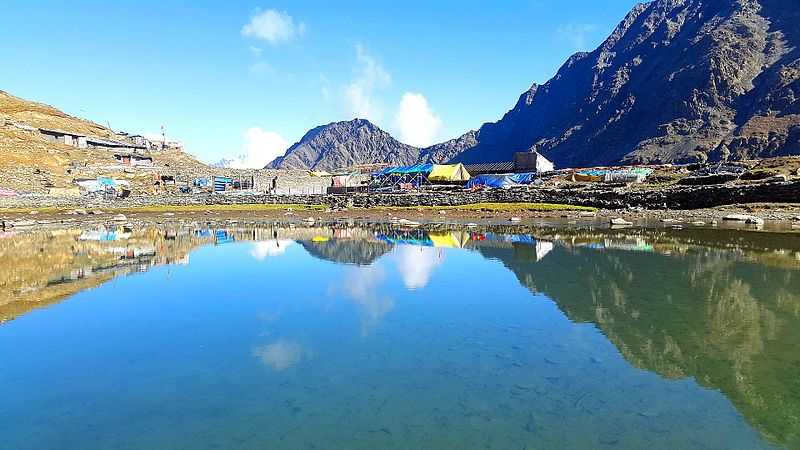
The trek starts from the village of Hadsar that is a small distance away from Chamba district in Himachal Pradesh. From Hadsar, the route leads to the hill village of Dancho. This trek can be undertaken even by amateur climbers as the slope is gradual and not very difficult. Here you can also find beautiful views of the Valley of Flowers and short bushy shrubs that have medicinal values.
Manimahesh Yatra Route
Manimahesh Yatra lasts for a total of 15 – 20 days and begins on the day of Janamasthmi also known as ‘Chota Snan’. It ends on the day of Radha Ashtami, also known as ‘Bada Snan’. There are three routes through which you can undertake this trek.
1. Bharmaur - Hadsar Route
- This journey starts at Bharmaur village when the pilgrims take a dip in the holy pond of the Bharmani Temple called the Bharmani Temple Kund.
- From Bharmaur, you can take a local bus to reach Hadsar village.
- The trek to Manimahesh Lake starts at Hadsar. On the way to the lake, you will find several resting points, eateries, camps and tents where you can halt your journey and stop for a rest.
- However, ideally, the next main stop is in Dhancho village. The trek from Hadsar to Dhancho is only 5 – 6 km and can be covered in 3 – 4 hours. On the way, you will also find several Bhandaras or Langars that will offer you free food.
- From Dhancho, the extreme left route leads up to the second last stop that is Gauri Kund. This route is known as Shiv Gharat. Aside from the beautiful scenery, you can also hear the wind against the mountains which is believed to sound like a melody of drums. This route leads to Gauri Kund which is supposed to be the bathing place of Goddess Parvati. While men are forbidden to even go near the pond, it is considered holy for women to take a dip in the pond.
- From Gauri Kund, Manimahesh Lake is only at a distance of 1 km. From the lake, you can spot the mighty Manimahesh peak in the distance. Pilgrims tend to take a dip in the chilling waters of the lake to seek Lord Shiva’s blessings.
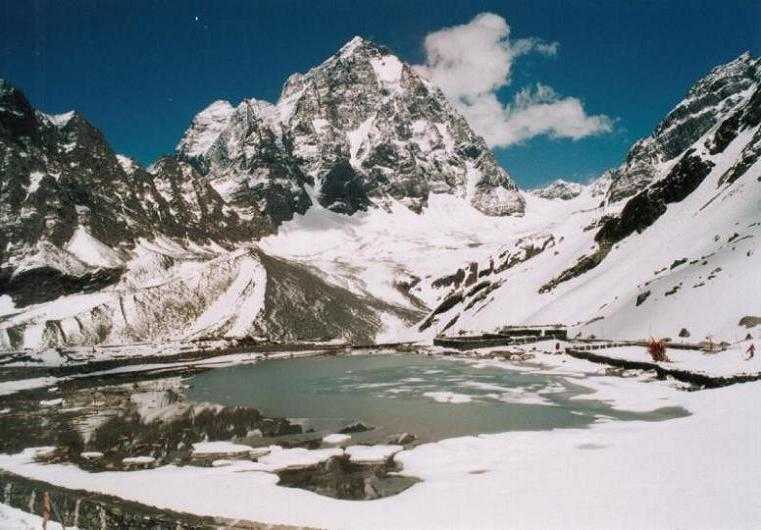
2. Parikrama Route - Via Kugti Village
The route via Kugti Village is considered more challenging and it is advised to be only undertaken by professional trekkers. This one goes a full circular trip around the Manimahesh peak and covers a total distance of 38 – 40 km. This route lets you enjoy the bounteous nature in all its glory. You can admire the lush green valleys, quaint village of Kugti, gurgling water streams, rocky terrains and mighty glaciers.
- This trek route also starts at Bharmour after taking a dip in the Bharmani Temple Kund and then reaching Hadsar.
- However, after reaching Hadsar, the next stop is not Dhancho but you will need to walk ahead to Dharol or Kugti Village. For reaching here, you can either hike or hire a vehicle. The total journey till Kugti will take around 3 – 4 hours through hiking.
- The actual trek starts from Kugti. Through a route of beautiful river streams and dense forest, you will reach Dhalotu. It is recommended to take a guide along with you.
- Next stop is Alyas where you can set up your tent and stay for the night. If you are trekking at the time of the Yatra, you will find tents setup beforehand by the locals. Alyas can be recognised by a huge saffron coloured rock known as Hanuman Garhi or Hanuman Shila.
- From Alyas, you can head off to Jotnu Pass. It is recommended to start this trek early in the morning (preferably at 7:00 AM) so you can reach your destination while the weather is still pleasant and clear. As the day passes, it might start snowing on the pass.
- Jotnu Pass is the last stop. From here, you can see the Manimahesh lake and you will take hardly 2 hours to reach your destination. On the way, you will also come across Dham Ghodi and Kamal Kund.
3. Yatra by Helicopter
Ofcourse, this is the easiest way to reach the Manimahesh lake. Other than being easy, this is also the most thrilling. However, this way is only open at the time of the Manimahesh Yatra and is especially for the pilgrims who face difficulty undertaking the trek. The base station for the helicopter ride is at Bharmour village and it only takes a total of only 7 min to reach the Gauri Kund. Manimahesh Lake is at a distance of 1 km from Gauri Kund that the pilgrims will have to trek to cross.
Rituals of the Manimahesh Yatra
The rituals and the grand Manimahesh Yatra begins when the sadhus and pandits herald the event through the procession of “Holy Chhari”. According to this custom, the pilgrims and sadhus carry a stick on their soldiers and commence the journey barefoot. This procession is followed by recitation and singing of hymns in praise of Lord Shiva. The journey continues with halts and resting stops in between.
After the pilgrims arrive at the lake, they perform several ceremonies and rituals throughout the night. On the next day, they take a dip in the holy waters of the Manimahesh lake- Shiv Karotri for men and Gauri Kund for women.
Legend of Manimahesh Lake
Manimahesh Lake is supposed to be the abode of the Hindu God Lord Shiva. It is believed that while Lord Shiva was performing penance here, a stream of water gushed out from his matted hair and took the shape of the lake. The lake, which is shaped like a saucer, has two different parts. The larger part is called ‘Shiv Karotri’ and has icy cold water. Devotees believe that Lord Shiva used to take bath here.

The other, smaller part, is situated at a small distance and has comparatively less chilly and lukewarm water which is called ‘Gauri Kund’. Women are supposed to take a dip in the Gauri Kund. On the periphery of the lake is also situated a large marble image of Lord Shiva called Chaumukha that is worshipped by the pilgrims. There is also a small temple that is presided by Lakshmi Devi.

How to Reach
The nearest airport is in Gaggal in Kangra which is at a distance of 170 km. Nearest railway station is in Pathankot in Punjab. From both these places, and also from neighbouring cities and towns, regular bus services are available that ply to and fro to Chamba. From Chamba, there are local buses and jeep services available that can take you to Bharmo
MANIMAHESH YATRA ROUTE
Bharmour is last town if you are going to Manimahesh. 13 km from Bharmour, Hadsar is the base village from where the trek to Manimahesh lake starts. Bharmour to Hadsar can be covered by local taxis charging 30/40 rupees/Person and 350/400 rupees if you book the taxi for yourself. Hadsar to Manimahesh needs to be covered by foot, around 13 km of steep climb along the bank of Manimahesh Ganga, which originates from the Manimahesh Kailash Peak.
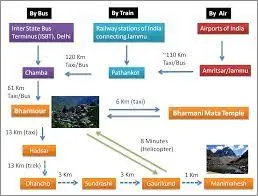
After reaching Bharmour, its better to start your journey early next morning. Reach Hadsar in 30-40 minutes. Then start your journey to Dhancho, which is 6 km away from hadsar and usually takes 5-7 hours. You can stay in Dhancho or can go same day to Manimahesh. Before Manimahesh lake there is Gauri Kund located 1 km before Manimahesh Lake.
The belief is that Lord Shiva used to take bath in Manimahesh Lake and goddess Gauri used to take bath in Gauri Kund. Only Women take a dip in Gauri kund and all others can take a dip in Manimahesh Lake.
During the annual pilgrimage in August-September, many night-shelters and eateries (Langar or Food) are present along the trekking route. Night-shelter is also available at village Dhanchoo, about 6 km from Hadsar on the way to Manimahesh.
As Manimahesh yatra is a state festival, accomodations are easily available. There are several Sewa Camps hosted by Sewaks from Himachal, Punjab (specially from Pathankot, Patiala, Amritsar, Muktsar) and from all over India. These Sewaks provide you with tented accommodations and free langar (food). These tented accommodations are provided both at Gauri Kund and Manimahesh lake.
Adventure activities are the must things to do in Barot Valley for those who love to explore thrilling experiences of adventure. Barot Valley offers a lot of adventure activities to explore and gives a chance to discover the adventures as a lifetime experience. This small valley provides an opportunity to its visitors to indulge in some of the most thrilling outdoor activities such as:
